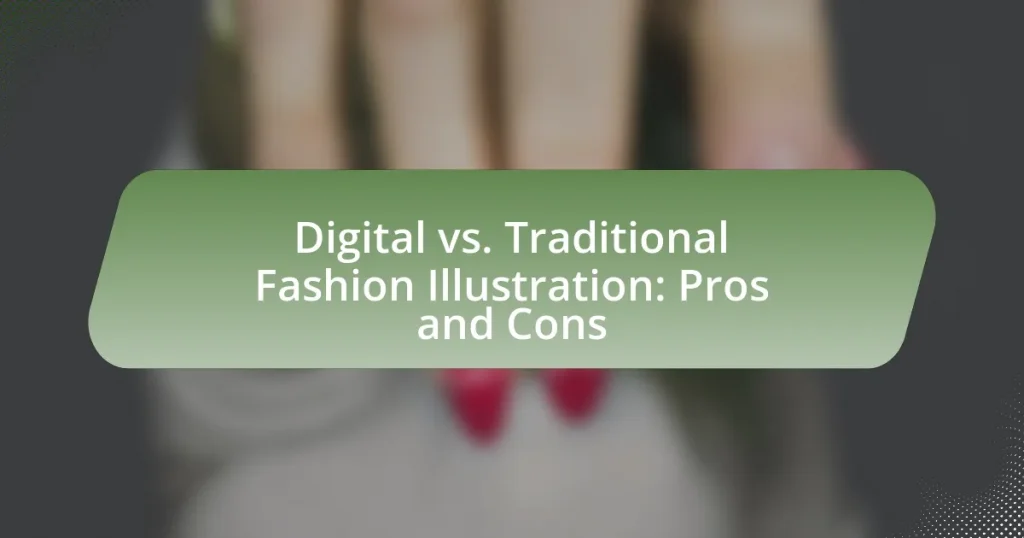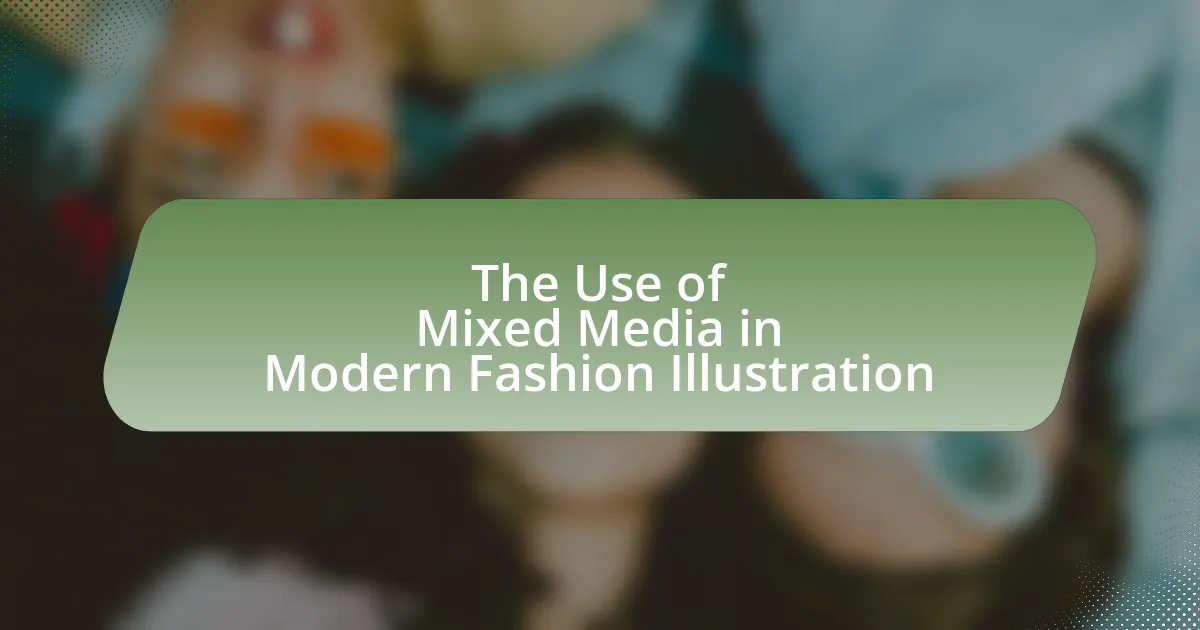The article examines the key differences between digital and traditional fashion illustration, highlighting their respective techniques, tools, and visual outcomes. Digital fashion illustration utilizes software and digital tools, offering advantages such as easy editing and a wide range of colors, while traditional illustration relies on physical mediums, providing a tactile experience and unique artistic qualities. The discussion includes the practical benefits of each method, the emotional connections artists have with their chosen mediums, and the challenges faced in both digital and traditional practices. Additionally, the article explores best practices for combining both styles to enhance creativity and efficiency in fashion illustration.
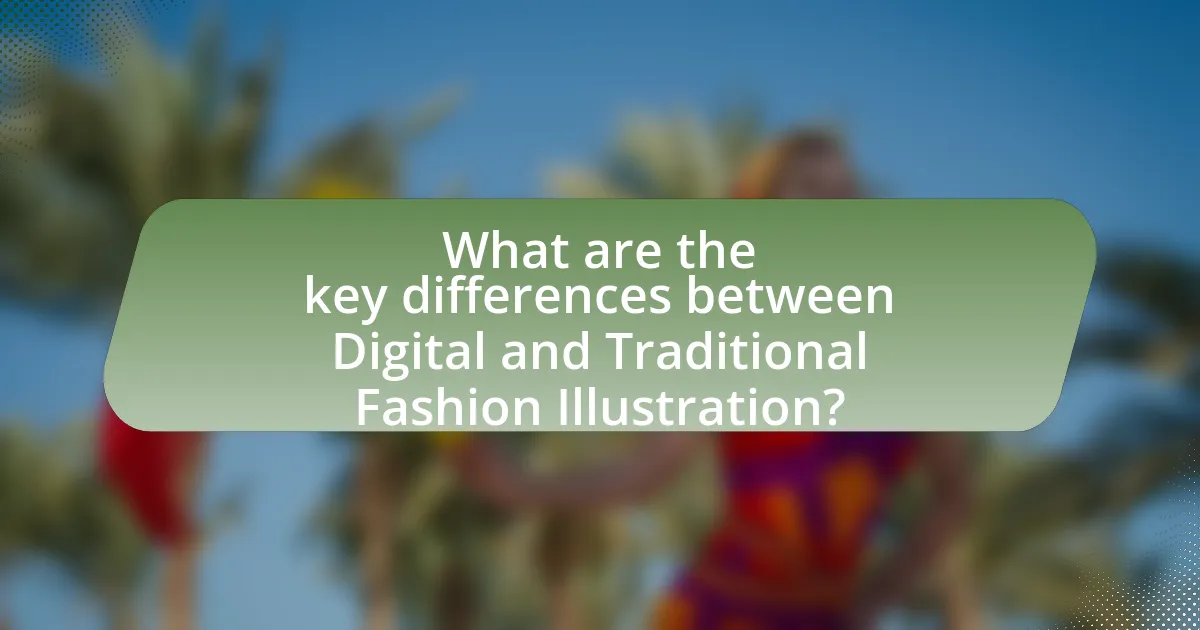
What are the key differences between Digital and Traditional Fashion Illustration?
Digital fashion illustration utilizes software and digital tools for creation, while traditional fashion illustration relies on physical mediums like pencils, inks, and paints. Digital illustrations offer advantages such as easy editing, the ability to use layers, and a wide range of colors and effects, which can enhance creativity and efficiency. In contrast, traditional illustrations provide a tactile experience and often convey a unique, organic quality that some artists and audiences prefer. The accessibility of digital tools has led to a significant increase in digital illustrations in the fashion industry, with reports indicating that over 70% of fashion designers now incorporate digital methods into their work.
How do Digital and Traditional Fashion Illustrations differ in technique?
Digital and traditional fashion illustrations differ primarily in their mediums and methods of creation. Traditional fashion illustrations utilize physical materials such as pencils, inks, watercolors, or markers on paper, allowing for a tactile and organic feel. In contrast, digital fashion illustrations are created using software tools like Adobe Illustrator or Procreate, enabling artists to manipulate colors, layers, and effects with precision and ease. This digital approach often allows for quicker revisions and the ability to easily share and reproduce artwork. The distinct techniques reflect the inherent characteristics of each medium, with traditional methods emphasizing craftsmanship and texture, while digital methods prioritize versatility and efficiency.
What tools are used in Digital Fashion Illustration?
Digital fashion illustration primarily utilizes software tools such as Adobe Illustrator, Adobe Photoshop, and CorelDRAW. These applications enable artists to create detailed and vibrant illustrations with precision and flexibility. Additionally, drawing tablets like Wacom or iPad Pro with Apple Pencil are commonly used to enhance the drawing experience, allowing for natural hand movements and pressure sensitivity. The integration of these tools facilitates a streamlined workflow, enabling quick revisions and the ability to easily manipulate designs, which is a significant advantage over traditional methods.
What materials are essential for Traditional Fashion Illustration?
Essential materials for Traditional Fashion Illustration include high-quality paper, pencils, inks, watercolors, and markers. High-quality paper provides a suitable surface for various media, while pencils allow for detailed sketches and initial designs. Inks are used for outlining and adding depth, while watercolors and markers offer vibrant color options to enhance illustrations. These materials are widely recognized in the fashion illustration community for their effectiveness in conveying texture, color, and style, making them fundamental to the traditional approach.
What are the visual outcomes of Digital vs. Traditional Fashion Illustration?
Digital fashion illustration typically results in sharper, more vibrant visuals due to the use of software that allows for precise color manipulation and layering. In contrast, traditional fashion illustration often features softer, more organic lines and textures, as it relies on physical mediums like watercolor or ink, which can create unique, hand-crafted effects. The digital medium enables artists to easily edit and iterate on designs, leading to a more polished final product, while traditional methods can convey a sense of authenticity and artistic flair that is often valued in the fashion industry.
How does color application vary between the two styles?
Color application in digital fashion illustration typically allows for greater precision and versatility compared to traditional methods. Digital tools enable artists to easily manipulate colors, create gradients, and apply effects with layers, which can enhance the overall visual impact. In contrast, traditional fashion illustration relies on physical mediums like watercolors or markers, which can limit color mixing and require more skill to achieve desired effects. This difference is evident in the ability of digital artists to quickly experiment with color palettes and make adjustments without the risk of damaging the artwork, a flexibility that traditional methods do not offer.
What are the differences in texture representation?
Texture representation in digital and traditional fashion illustration differs primarily in technique and outcome. Traditional illustration often utilizes physical materials like pencils, inks, and paints, which create unique textures through layering and brushwork, resulting in organic and tactile qualities. In contrast, digital illustration employs software tools that simulate textures, allowing for precise control and the ability to easily manipulate and replicate textures without the limitations of physical media. For instance, digital tools can create textures that mimic fabric weaves or surface finishes with high accuracy, which can be adjusted in real-time. This distinction highlights how traditional methods emphasize the artist’s hand and materiality, while digital methods focus on versatility and reproducibility.
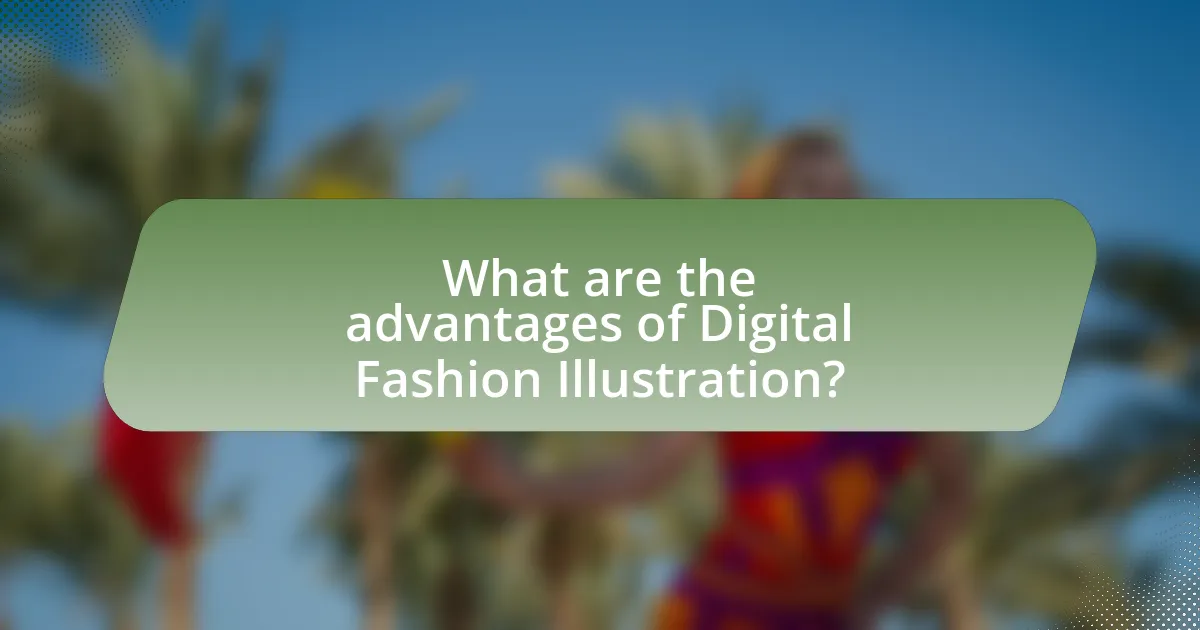
What are the advantages of Digital Fashion Illustration?
Digital fashion illustration offers several advantages, including efficiency, versatility, and ease of sharing. The digital medium allows artists to create and modify designs quickly, significantly reducing the time required for revisions compared to traditional methods. Additionally, digital tools provide a wide range of options for colors, textures, and effects, enabling artists to experiment and innovate without the limitations of physical materials. Furthermore, digital illustrations can be easily shared across various platforms, facilitating collaboration and reaching a broader audience, which is essential in the fast-paced fashion industry. These advantages make digital fashion illustration a preferred choice for many designers and artists today.
How does Digital Fashion Illustration enhance creativity?
Digital Fashion Illustration enhances creativity by providing artists with versatile tools that facilitate experimentation and innovation. The digital medium allows for rapid alterations, enabling designers to explore multiple concepts and color palettes without the constraints of traditional materials. For instance, software like Adobe Illustrator and Procreate offers features such as layering, undo options, and a vast array of brushes, which can lead to unique artistic expressions. Studies have shown that digital platforms can increase the speed of the creative process, allowing for more ideas to be generated in a shorter time frame, thus fostering a more dynamic creative environment.
What features allow for greater experimentation in Digital Illustration?
Greater experimentation in digital illustration is facilitated by features such as layers, undo functionality, and a wide array of brushes and tools. Layers allow artists to separate different elements of their work, enabling modifications without affecting the entire composition. The undo functionality provides the freedom to explore various ideas without the fear of making irreversible mistakes. Additionally, the extensive selection of customizable brushes and tools empowers artists to create unique textures and effects, fostering innovation in their designs. These features collectively enhance the creative process, making digital illustration a versatile medium for experimentation.
How does the editing process differ in Digital Illustration?
The editing process in digital illustration differs significantly from traditional illustration due to the inherent capabilities of digital tools. In digital illustration, artists can easily manipulate layers, adjust colors, and apply effects without permanently altering the original artwork, allowing for non-destructive editing. This flexibility enables rapid experimentation and iteration, as changes can be made quickly and reverted if necessary. In contrast, traditional illustration often requires physical alterations, such as erasing or painting over sections, which can be time-consuming and may compromise the integrity of the original piece. The digital medium also supports advanced features like undo functions and the use of software tools that streamline the editing process, enhancing efficiency and creativity.
What practical benefits does Digital Fashion Illustration offer?
Digital Fashion Illustration offers several practical benefits, including efficiency, versatility, and ease of sharing. The digital medium allows artists to create illustrations faster than traditional methods, as tools like layers and undo functions streamline the design process. Additionally, digital illustrations can be easily modified, enabling designers to experiment with colors, patterns, and styles without starting from scratch. The ability to share digital files instantly across various platforms enhances collaboration among designers, clients, and manufacturers, facilitating quicker feedback and decision-making. These advantages contribute to a more dynamic and responsive fashion design process.
How does Digital Illustration improve workflow efficiency?
Digital illustration improves workflow efficiency by enabling faster revisions and easier collaboration among team members. Unlike traditional methods, digital tools allow artists to make instant changes without the need for physical materials, which can be time-consuming. For instance, software like Adobe Illustrator provides features such as layers and undo options, allowing for quick adjustments and experimentation. This capability significantly reduces the time spent on each project, as illustrated by a study from the University of Southern California, which found that digital workflows can cut project turnaround times by up to 30%.
What cost advantages does Digital Fashion Illustration provide?
Digital Fashion Illustration offers significant cost advantages, primarily through reduced material expenses and increased efficiency. Unlike traditional methods that require physical materials such as paper, paints, and inks, digital illustration relies on software and hardware, which can be more cost-effective over time. For instance, artists can create multiple iterations without the need for additional supplies, thus minimizing waste and lowering overall costs. Additionally, digital tools often allow for quicker revisions and faster production times, which can lead to lower labor costs and increased output. This efficiency is supported by studies indicating that digital processes can reduce project timelines by up to 30%, further enhancing cost-effectiveness in the fashion industry.
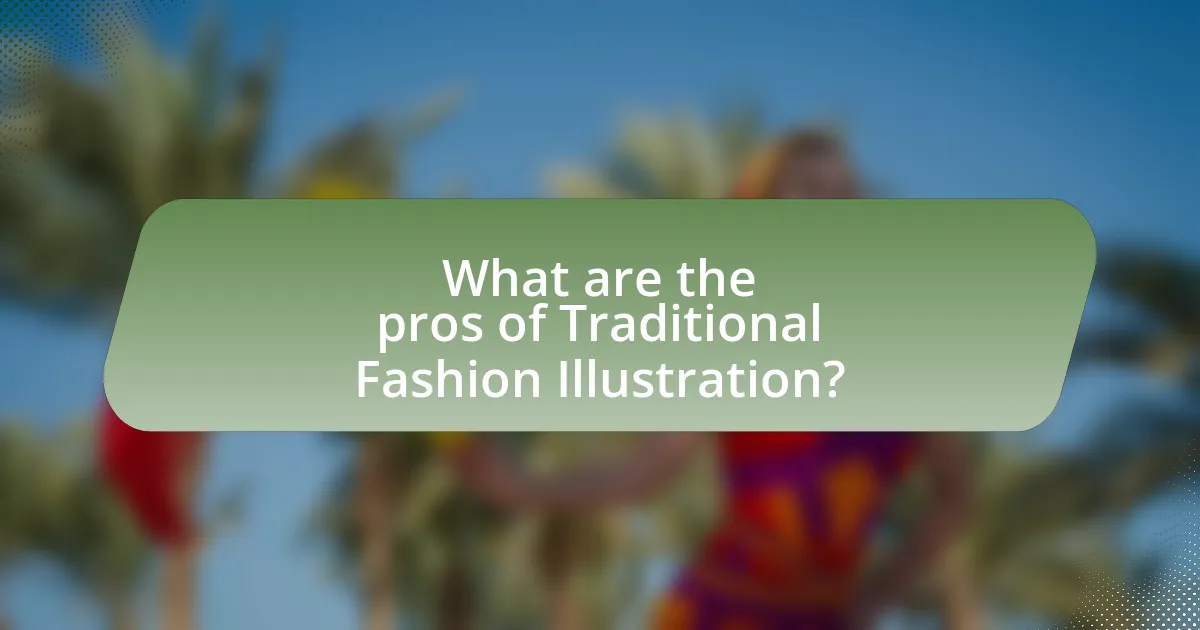
What are the pros of Traditional Fashion Illustration?
Traditional fashion illustration offers several advantages, including a unique artistic quality and a tactile connection to the medium. The hand-drawn nature of traditional illustrations allows for a distinct style that can convey emotion and creativity in ways that digital methods may not replicate. Additionally, traditional techniques often emphasize the artist’s personal touch, which can enhance the authenticity of the artwork. Historical significance also plays a role; traditional fashion illustration has been a foundational aspect of fashion marketing and design since the 19th century, establishing a rich legacy that continues to influence contemporary practices.
How does Traditional Fashion Illustration contribute to artistic authenticity?
Traditional fashion illustration contributes to artistic authenticity by emphasizing the unique, hand-crafted qualities of the artwork, which reflect the individual style and vision of the artist. This form of illustration often showcases techniques such as watercolor, ink, and pencil, allowing for a personal touch that digital methods may lack. The historical context of traditional fashion illustration, which dates back to the 19th century, highlights its role in shaping fashion trends and communicating artistic expression, thereby reinforcing its authenticity. Furthermore, the tactile nature of traditional materials can evoke emotional responses and a sense of connection to the artist, enhancing the overall authenticity of the work.
What emotional connections do artists have with Traditional methods?
Artists often have deep emotional connections with traditional methods due to the tactile experience and personal history associated with these techniques. Traditional methods, such as painting or drawing, allow artists to engage physically with their materials, fostering a sense of intimacy and authenticity in their work. This connection is often rooted in nostalgia, as many artists recall their early experiences with these methods, which can evoke feelings of comfort and familiarity.
Furthermore, traditional methods often carry cultural significance, linking artists to their heritage and the historical context of their craft. For instance, techniques like watercolor painting or charcoal drawing have been used for centuries, creating a lineage that artists feel a part of, enhancing their emotional investment. The unique imperfections and variations in traditional artwork also contribute to a sense of individuality and personal expression, reinforcing the emotional bond artists have with these methods.
How does the tactile experience influence the final artwork?
The tactile experience significantly influences the final artwork by enhancing the artist’s connection to the materials and the creative process. In traditional fashion illustration, the physical interaction with mediums such as paper, paint, and fabric allows artists to explore textures and layering, which can lead to more nuanced and expressive outcomes. For instance, the use of charcoal or watercolor can create unique effects that are difficult to replicate digitally. Research indicates that artists often report a deeper emotional engagement with their work when using tactile materials, as the sensory feedback informs their decisions and techniques. This connection can result in artwork that feels more authentic and personal, ultimately impacting the viewer’s perception and emotional response.
What are the unique benefits of Traditional Fashion Illustration in the industry?
Traditional fashion illustration offers unique benefits such as a tactile quality and a distinct artistic style that digital methods often lack. The hand-drawn elements provide a sense of authenticity and individuality, allowing designers to convey emotions and concepts in a way that resonates with viewers. Additionally, traditional techniques can capture textures and nuances that may be difficult to replicate digitally, enhancing the visual storytelling aspect of fashion. Historical significance also plays a role; traditional illustrations have been foundational in the fashion industry, influencing trends and styles since the 19th century, thus establishing a rich legacy that continues to inspire contemporary designers.
How does Traditional Illustration appeal to certain audiences?
Traditional illustration appeals to certain audiences through its tactile quality and nostalgic value. Many individuals appreciate the craftsmanship involved in traditional techniques, such as watercolor or pencil, which convey a sense of authenticity and emotional depth. This appeal is particularly strong among art enthusiasts and collectors who value original works and the unique imperfections that come with hand-drawn art. Additionally, traditional illustration often evokes a sense of nostalgia, resonating with audiences who have a fondness for classic styles and historical art movements. Studies indicate that consumers are more likely to connect emotionally with artwork that showcases human touch, reinforcing the preference for traditional methods in specific demographics.
What role does Traditional Fashion Illustration play in fashion history?
Traditional fashion illustration has played a crucial role in fashion history by serving as a primary means of visual communication for designers and brands before the advent of digital technology. Historically, these illustrations were essential for showcasing new collections, conveying design ideas, and influencing public perception of fashion trends. For instance, during the 19th and early 20th centuries, prominent illustrators like Charles Dana Gibson and Erté helped define the aesthetic of their eras, shaping consumer tastes and the fashion industry itself. This visual art form not only documented styles but also reflected cultural shifts, making it a vital component of fashion’s evolution.
What are the challenges faced by artists in both Digital and Traditional Fashion Illustration?
Artists in both digital and traditional fashion illustration face several challenges, including the need for technical proficiency, market competition, and evolving trends. Technical proficiency is essential as artists must master various tools and software for digital illustration, while traditional artists need to be skilled in manual techniques and materials. Market competition is intense, with numerous artists vying for attention, making it difficult to establish a unique style and gain recognition. Additionally, artists must continuously adapt to evolving fashion trends and consumer preferences, which can be demanding and requires ongoing research and creativity. These challenges highlight the complexities of navigating both mediums in the fashion illustration industry.
What common obstacles do artists encounter in Digital Illustration?
Artists encounter several common obstacles in digital illustration, including technical challenges, software limitations, and the learning curve associated with new tools. Technical challenges often arise from hardware issues, such as insufficient processing power or inadequate graphics tablets, which can hinder the creative process. Software limitations may restrict artists in terms of features or compatibility with other programs, impacting their workflow. Additionally, the learning curve for mastering complex software can be steep, requiring significant time and effort to achieve proficiency. These obstacles can affect productivity and the overall quality of the artwork produced.
What limitations do artists face with Traditional methods?
Artists face several limitations with traditional methods, including a lack of flexibility and the inability to easily correct mistakes. Traditional mediums, such as paint and ink, require significant time and effort to apply, making it challenging to experiment or modify work once it is underway. Additionally, the physical materials can be costly and require specific storage conditions, which can limit accessibility for artists. According to a study by the National Endowment for the Arts, artists often report that the permanence of traditional materials can hinder their creative process, as they may feel pressured to produce flawless work.
What should artists consider when choosing between Digital and Traditional Fashion Illustration?
Artists should consider the intended use, personal skill set, and the unique characteristics of each medium when choosing between Digital and Traditional Fashion Illustration. The intended use influences the choice; for instance, digital illustrations are often preferred for online platforms due to their ease of editing and sharing, while traditional illustrations may be favored for print media where texture and authenticity are valued. Additionally, an artist’s skill set plays a crucial role; those proficient in digital tools may find digital illustration more efficient, whereas artists with a strong background in traditional techniques may prefer the tactile experience of traditional media. Each medium also offers distinct characteristics: digital illustration allows for unlimited color options and easy corrections, while traditional illustration provides a unique aesthetic and physical presence that can enhance the artwork’s appeal.
How can an artist determine which style suits their personal brand?
An artist can determine which style suits their personal brand by evaluating their unique artistic voice and the audience they wish to engage. This involves analyzing their strengths, preferences, and the emotional response their work elicits. For instance, artists who excel in detailed, realistic portrayals may find that traditional illustration aligns better with their brand, while those who prefer bold colors and abstract forms might thrive in digital formats. Research indicates that artists who align their style with their personal values and the expectations of their target audience tend to achieve greater recognition and success in their field.
What factors influence the decision based on project requirements?
The decision based on project requirements is influenced by factors such as the target audience, budget constraints, timeline, and the specific goals of the project. For instance, if the target audience prefers modern aesthetics, digital illustration may be favored due to its versatility and ease of modification. Budget constraints can dictate whether traditional methods, which may require more materials and time, are feasible. Additionally, project timelines often favor digital methods for their efficiency in production. Lastly, the project’s goals, such as the need for high detail or a specific artistic style, can determine the choice between digital and traditional illustration techniques.
What are the best practices for combining Digital and Traditional Fashion Illustration?
The best practices for combining digital and traditional fashion illustration include integrating the strengths of both mediums to enhance creativity and efficiency. Artists should start by sketching initial concepts using traditional methods, such as pencil or ink, to capture organic lines and textures, which can then be scanned and imported into digital software for refinement and color application. This hybrid approach allows for the unique qualities of hand-drawn illustrations to be preserved while leveraging digital tools for versatility and ease of editing. Additionally, utilizing layers in digital programs can facilitate experimentation with different styles and color palettes without compromising the original artwork. This method is supported by the fact that many contemporary fashion illustrators, such as David Downton, successfully blend both techniques to create distinctive and dynamic visuals.
